Bimotor Scirocco
Source: "VW Power and Style" by Ian Kuah
|
Brought to you by DriversFound.com |
| "With the twin-engined formula
working successfully in the Jetta with standard engines, VW Motorsport were confident
enough now to shoot for the limits of the drivetrain's capability with the twin-engined
Scirocco. The new 1,781cc engine slated for 1983 model-year production was not yet
available, so VW Motorsport asked its contract engine builder, Eckhart Berg, to increase
the bore and stroke of the existing 1.6-litre engine to achieve the larger capacity. With
a bore and stroke at 81.25mm x 86.4mm, the larger engine worked out at 1,791cc and the
twin engines were thus equivalent to a 3.58-litre eight-cylinder unit. Internally, forged
pistons and reworked combustion |
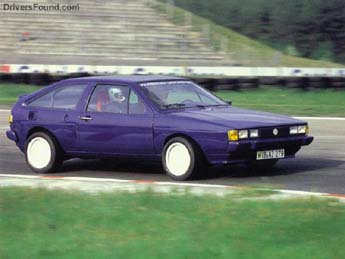 |
| chambers increased the compression
ratio to 10.9:1 and, with hotter camshafts, the output of each engine was 180bhp @
7,200rpm with 148lb/ft of torque at 5,800rpm. Helping to achieve this was a Zenith
Pierburg racing fuel injection system with one throttle body per cylinder. These were
basically rallycross-spec motors. Two
twin-engined Sciroccos were to be built, one for evaluation and
testing and another to do shows and the like. The first car
was also built to convince the VW Board of the potential of the car, and it just happened
to have 54bhp more than the Audi Sport quattro rally homologation special, which it
equalled in acceleration and bettered in top speed, through taller gearing. VW Motorsport
and Audi Sport were run as two distinct and separate departments and one detects an
element of rivalry between them spurring the VW engineers on, for it was the Audi branch
that was getting all the limelight in international rallying at this period.
The power was fed through a pair of single-plate
sintered-metal clutches to identical five-speed gearboxes. Each end of the car had a
limited-slip differential and, if a high final-drive ratio was opted for, the theoretical
top speed was close to 180mph. In the event, the car ran with a short final drive and this
gave it blistering acceleration. 0-60mph took a mere 4.5 seconds, enough to embarrass a
Porsche 911 Turbo. 100mph followed 7 seconds after that and the quarter-mile trap closed
on the car in 13 seconds.
Perhaps the most ingenious feature of the twin-engined
Scirocco was the way the engines were synchronised. Given the title 'E-gas', which means
electronic hookup, the linking system was deceptively simple. A single throttle cable ran
back to the rear engine where a potentiometer measured throttle position and sent a signal
forward to operate a valve on the other engine. While the Scirocco retained the ability of
the Jetta to run on front, rear or both engines, it had the additional refinement of a
slide-operated throttle potentiometer which adjusted front engine power and thus the
front-rear power split. The car was hardly nose heavy with a good 52.6/47.4% front/rear
weight distribution, but even so it was a great advantage to be able to dial in different
handling characteristics at will, especially when it came to countering understeer on
loose surfaces. The gearboxes were mechanically linked by rods and cranks, with a small
pneumatically operated plunger device connecting each of these assemblies near the gearbox
to lock out one or the other shift mechanism in the event of a single engine failure.
The bodyshell modifications were different from those of the
twin-motor Jetta. A suitable hole was cut in the shell to accept the rear drivetrain which
had to be angled forward from the rear axle line. The other modifications followed the
proven formula used on the Twin-Jet however, and Bilstein dampers were used together with
adjustable suspension, and 10.5in vented disc brakes all round with four-pot racing
calipers. The wheels were 7J x 15in Centra alloys shod with 205/50VR15 Pirelli P7s.
|
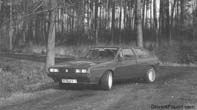  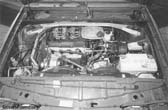 
|
| The second Bimotor Scirocco
was a rather different animal. The project was now in the hands of Dr. Ulrich Seifert at
VW's Development Department and this metallic red car was brought to a state of finish
where it could have been put into limited production. The car wore a specially molded body
kit which encompassed front and rear bumpers, and quattro-style wheelarch flares with
engine intake grilles let into the leading edge of the rear ones. (Wheels were from an
early Audi quattro.) The twin exhaust pipes at the rear were neatly centred in
semi-circular cutouts rather than simply protruding from the bodywork. Open the rear
hatch, and the standard of finish continued to |
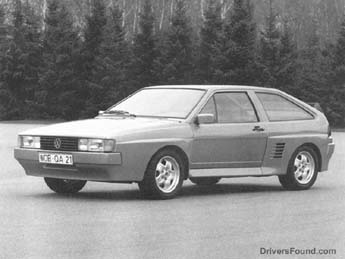 |
| impress. The engine compartment
surround was braced with a metal frame that formed a rigid structure from the tail panel
to the bulkhead, and this was carpeted. With the engine cover in place, the whole
installation was hidden from view. The interior
of the car was equally neat. Instead of a battery of supplementary gauges hogging the
centre console as in the first prototype, a custom made instrument panel had been
assembled specially from the car by VDO who make all the instruments for VW. Fitting into
the standard instrument pack hole, this contained a matching pair of rev counters with an
LCD-readout speedometer in between. The bottom of each rev counter contained a small water
temperature and oil temperature gauge, mirror imaged, and in the centre was the petrol
gauge.
|
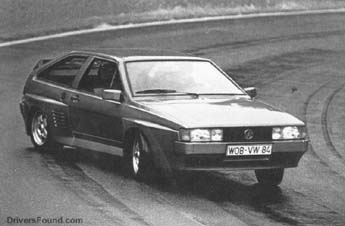 |
The underbonnet view was
impressive. Now that the factory 1,781cc engine was in production, this early 1983
prototype was able to use the new block and coupled this to Oettinger 16-valve heads. This
1800E/16 engine gave 141bhp at 6,100rpm and 125lb/ft of torque at 5,500rpm. The fuel
system was a modified Bosch K-Jetronic and the compression ratio was 10.2:1. The surprise factor in this research vehicle was that the complex gear
linkages connecting the two five-speed manual gearboxes had been dispensed |
| with in one fell swoop by using a
pair of three-speed automatic gearboxes. The torque convertors were modified to optimize
their response and the gearbox changeup points were adjusted to suit the characteristics
of the sporting Oettinger engines, and the whole set-up worked very well because the
slight slip in the torque convertors would help to compensate when the two engines were
running out of synchronization, as when the power balance between the front and rear
engines was being modified." |
| |
|
|